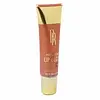What's inside
What's inside
 Key Ingredients
Key Ingredients

 Benefits
Benefits

 Concerns
Concerns

 Ingredients Side-by-side
Ingredients Side-by-side

Polybutene
Paraffinum Liquidum
EmollientBis-Diglyceryl Polyacyladipate-2
EmollientOctyldodecanol
EmollientCaprylic/Capric Triglyceride
MaskingSilica Dimethyl Silylate
EmollientBeeswax
Emulsion StabilisingButylene/Ethylene/Styrene Copolymer
Ethylene/Propylene/Styrene Copolymer
Triacontanyl Pvp
HumectantPhenoxyethanol
PreservativeParfum
MaskingSorbic Acid
PreservativeTocopheryl Acetate
AntioxidantVitis Vinifera Seed Oil
EmollientGlycine Soja Oil
EmollientTocopherol
AntioxidantAloe Barbadensis Leaf Extract
EmollientPentaerythrityl Tetraisostearate
EmollientSilica
AbrasiveCI 42090
Cosmetic ColorantCI 75470
Cosmetic ColorantIron Oxides
CI 77492
Cosmetic ColorantCI 77499
Cosmetic ColorantMica
Cosmetic ColorantCI 45410
Cosmetic ColorantCI 73360
Cosmetic ColorantCI 17200
Cosmetic ColorantCI 15850
Cosmetic ColorantTitanium Dioxide
Cosmetic ColorantCI 19140
Cosmetic ColorantPolybutene, Paraffinum Liquidum, Bis-Diglyceryl Polyacyladipate-2, Octyldodecanol, Caprylic/Capric Triglyceride, Silica Dimethyl Silylate, Beeswax, Butylene/Ethylene/Styrene Copolymer, Ethylene/Propylene/Styrene Copolymer, Triacontanyl Pvp, Phenoxyethanol, Parfum, Sorbic Acid, Tocopheryl Acetate, Vitis Vinifera Seed Oil, Glycine Soja Oil, Tocopherol, Aloe Barbadensis Leaf Extract, Pentaerythrityl Tetraisostearate, Silica, CI 42090, CI 75470, Iron Oxides, CI 77492, CI 77499, Mica, CI 45410, CI 73360, CI 17200, CI 15850, Titanium Dioxide, CI 19140
Polyisobutene
Ethylhexyl Palmitate
EmollientHydrogenated Polyisobutene
EmollientSilica Dimethyl Silylate
EmollientPrunus Amygdalus Dulcis Oil
Skin ConditioningTocopheryl Acetate
AntioxidantEthylene/Propylene/Styrene Copolymer
Caprylyl Glycol
EmollientStevia Rebaudiana Extract
Glycerin
HumectantCaprylhydroxamic Acid
Butylene/Ethylene/Styrene Copolymer
Mica
Cosmetic ColorantPentaerythrityl Tetra-Di-T-Butyl Hydroxyhydrocinnamate
AntioxidantParfum
MaskingBenzyl Benzoate
AntimicrobialCI 77891
Cosmetic ColorantPolyisobutene, Ethylhexyl Palmitate, Hydrogenated Polyisobutene, Silica Dimethyl Silylate, Prunus Amygdalus Dulcis Oil, Tocopheryl Acetate, Ethylene/Propylene/Styrene Copolymer, Caprylyl Glycol, Stevia Rebaudiana Extract, Glycerin, Caprylhydroxamic Acid, Butylene/Ethylene/Styrene Copolymer, Mica, Pentaerythrityl Tetra-Di-T-Butyl Hydroxyhydrocinnamate, Parfum, Benzyl Benzoate, CI 77891
 Reviews
Reviews

Ingredients Explained
These ingredients are found in both products.
Ingredients higher up in an ingredient list are typically present in a larger amount.
We don't have a description for Butylene/Ethylene/Styrene Copolymer yet.
We don't have a description for Ethylene/Propylene/Styrene Copolymer yet.
Mica is a naturally occurring mineral used to add shimmer and color in cosmetics. It can also help improve the texture of a product or give it an opaque, white/silver color.
Serecite is the name for very fine but ragged grains of mica.
This ingredient is often coated with metal oxides like titanium dioxide. Trace amounts of heavy metals may be found in mica, but these metals are not harmful in our personal products.
Mica has been used since prehistoric times throughout the world. Ancient Egyptian, Indian, Greek, Roman, Aztec, and Chinese civilizations have used mica.
Learn more about MicaParfum is a catch-all term for an ingredient or more that is used to give a scent to products.
Also called "fragrance", this ingredient can be a blend of hundreds of chemicals or plant oils. This means every product with "fragrance" or "parfum" in the ingredients list is a different mixture.
For instance, Habanolide is a proprietary trade name for a specific aroma chemical. When used as a fragrance ingredient in cosmetics, most aroma chemicals fall under the broad labeling category of “FRAGRANCE” or “PARFUM” according to EU and US regulations.
The term 'parfum' or 'fragrance' is not regulated in many countries. In many cases, it is up to the brand to define this term.
For instance, many brands choose to label themselves as "fragrance-free" because they are not using synthetic fragrances. However, their products may still contain ingredients such as essential oils that are considered a fragrance by INCI standards.
One example is Calendula flower extract. Calendula is an essential oil that still imparts a scent or 'fragrance'.
Depending on the blend, the ingredients in the mixture can cause allergies and sensitivities on the skin. Some ingredients that are known EU allergens include linalool and citronellol.
Parfum can also be used to mask or cover an unpleasant scent.
The bottom line is: not all fragrances/parfum/ingredients are created equally. If you are worried about fragrances, we recommend taking a closer look at an ingredient. And of course, we always recommend speaking with a professional.
Learn more about ParfumThis silica is mainly used to thicken oils and suspend particles in oils. It is not water soluble.
According to the manufacturer, it:
The manufacturer also claims this ingredient to be useful in makeup.
In lipstick formulations, this ingredient improves color payoff, reduces pigment settling, and reduces oil bleeding. This ingredient also improves the grip of powder products such as dry shampoos.
Learn more about Silica Dimethyl SilylateTocopheryl Acetate is AKA Vitamin E. It is an antioxidant and protects your skin from free radicals. Free radicals damage the skin by breaking down collagen.
One study found using Tocopheryl Acetate with Vitamin C decreased the number of sunburned cells.
Tocopheryl Acetate is commonly found in both skincare and dietary supplements.
Learn more about Tocopheryl Acetate